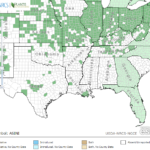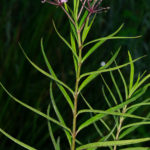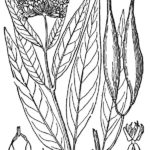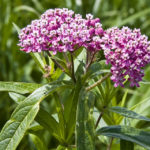Asclepias incarnata
USDA, NRCS. 2018. The PLANTS Database (http://plants.usda.gov, 28 March 2018). National Plant Data Team, Greensboro, NC 27401-4901 USA.
Illustration: USDA-NRCS PLANTS Database / Britton, N.L., and A. Brown. 1913. An illustrated flora of the northern United States, Canada and the British Possessions. 3 vols. Charles Scribner’s Sons, New York. Vol. 3: 26.
What is Swamp Milkweed?
Other common spellings and names include: pink milkweed.
Physical Characteristics
Leaves:
- Opposite
- Egg or sword-shaped
- 2-5 inches long
- Up to 1.5 inches wide
- Leaf stalks up to 0.39 inches long
Flowers:
- Usually paired at nodes
- Many flowered
- Small
- Bright pink, rarely white in color
Fruit:
- Dry
- Opens on one side to release seed when ripe
- Spindle-shaped
- 2.75-3.5 inches long
- Up to 0.5 inch thick
- Smooth
Seeds:
- Oval-shaped
- 0.28-0.39 inches long
Stem:
- Sturdy
- 1.25-5 feet tall
- Branching
Roots:
- Short rootstalks
Where Does it Grow?
Swamp milkweed is an obligate wetland plant for the Gulf Coastal prairie and midwest regions and a facultative plant for the Great Plains region. Swamp milkweed can be found in marshes and long the edges of lakes and streams.
Bloom Color: Pink , Purple
Bloom Time: Jun , Jul , Aug , Sep , Oct
Pros and Cons of Swamp Milkweed
Milkweed is the only plant eaten by Monarch butterfly caterpillars, one of the reasons their numbers are dropping is the loss of space for milkweed to grow due to mowing or pesticides.
Flowers are beneficial to native bees.
Submerged portions of all aquatic plants provide habitats for many micro and macro invertebrates. These invertebrates in turn are used as food by fish and other wildlife species (e.g. amphibians, reptiles, ducks, etc.). After aquatic plants die, their decomposition by bacteria and fungi provides food (called “detritus”) for many aquatic invertebrates.







